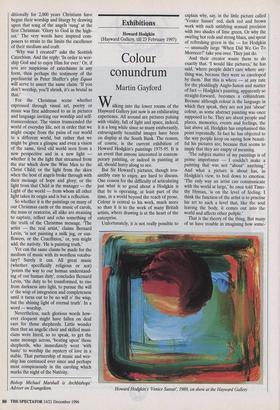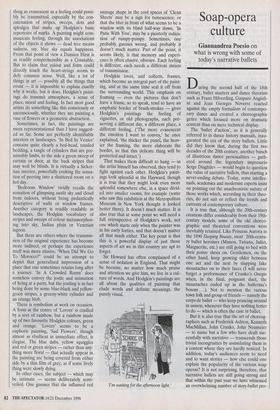Exhibitions
Howard Hodgkin (Hayward Gallery, till 23 February 1997)
Colour conundrum
Martin Gaylord
Walking into the lower rooms of the Hayward Gallery just now is an exhilarating experience. All around are pictures pulsing with vitality, full of light and space, indeed, it is a long while since so many exuberantly, extravagantly beautiful images have been on display at the South Bank. The reason, of course, is the current exhibition of Howard Hodgkin's paintings 1975-95. It is an event that anyone interested in contem- porary painting, or indeed in painting at all, should hurry along to see.
But Sir Howard's pictures, though irre- sistibly easy to enjoy, are hard to discuss. One reason for the difficulty of articulating just what is so good about a Hodgkin is that he is operating, at least part of the time, in a world beyond the reach of prose. Colour is central to his work, much more so than it is to the work of many British artists, where drawing is at the heart of the enterprise.
Unfortunately, it is not really possible to explain why, say, in the little picture called 'Venice Sunset' red, dark red and brown work with such satisfying sensual precision with two shades of lime green. Or why the swirling hot reds and strong blues, and spout of refreshing green in the — for Hodgkin — unusually large 'When Did We Go To Morocco?' take you over. They just do.
And their creator wants them to do exactly that. 'I would like pictures,' he has said, 'where people didn't care where any- thing was, because they were so enveloped by them.' But this is where — at any rate for the ploddingly Anglo-Saxon and matter of fact — Hodgkin's painting, apparently so straight-forward, becomes a conundrum. Because although colour is the language in which they speak, they are not just 'about' colour, as some abstract painting was once supposed to be. They are about people and places, memories, events and feelings, the last above all. Hodgkin has emphasised this point repeatedly. In fact he has objected to the way people keep on saying how beauti- ful his pictures are, because that seems to imply that they are empty of meaning.
'The subject matter of my paintings is of prime importance — I couldn't make a painting that was not "about" anything.' And what a picture is about has, in Hodgkin's view, to boil down to emotion. 'The only way an artist can communicate with the world at large,' he once told Timo- thy Hyman, 'is on the level of feeling. I think the function of the artist is to practise his art to such a level that, like the soul leaving the body, it comes out into the world and affects other peeple.'
That is the theory of the thing. But many of us have trouble in imagining how some- Howard Hodgkin's 'Venice Sunset', 1989, on show at the Hayward Gallery thing as evanescent as a feeling could possi- bly be transmitted, especially by the con- catenation of stripes, sweeps, dots and splodges that make up Hodgkin's basic repertoire of marks. A painting might com- municate feeling, through the associations of the objects it shows — dead tree means sadness, say, blue sky equals happiness. From that point of view a Damien Hirst is as readily comprehensible as a Constable. But to claim that colour and form could directly touch the heart-strings seems to defy common sense. Well, like a lot of things in art — possibly all the things that count — it is impossible to explain exactly why it works, but it does. Hodgkin's paint- ings do transmit atmosphere, a sense of place, mood and feeling. In fact most good artists do something like this consciously or unconsciously, whether they are painting a vase of flowers or a geometric abstraction.
Sometimes, in fact, the paintings are more representational than I have suggest- ed so far. Some are perfectly identifiable interiors or landscapes. 'In Bed In Venice' contains quite clearly a bed-head, tousled bedding, a tangle of cylinders that are pre- sumably limbs, to the side a green sweep of curtain or door, at the back stripes that may well be blinds. It is virtually a Sicker- tian interior, powerfully evoking the sensa- tion of peering into a shuttered room on a hot day.
'Bedroom Window' vividly recalls the sensation of glimpsing sunlit sky and cloud from indoors, without being pedantically descriptive of walls or window frames. Another category is readily readable as landscapes, the Hodgkin vocabulary of stripes and sweeps of colour metamorphos- ing into sky, Indian plain or Venetian lagoon.
But there are others where the transmis- sion of the original experience has become more indirect, or perhaps the experience itself was more elusive. 'When Did We Go To Morocco?' could be an attempt to depict that generalised impression of a place that one sometimes retains long after a journey. 'In A Crowded Room' does somehow convey the jostle and animation of being at a party, but the jostling is in fact being done by some blue-black and yellow- green stripes, a greeny-white cylinder and an orange blob.
There is symbolism at work on occasion. A form at the centre of 'Lovers' is cradled by a sort of rainbow, but a rainbow made up of two favourite Hodgkin colours, green and orange. 'Lovers' seems to be a euphoric painting, 'Sad Flowers', though almost as ebullient in immediate effect, is elegiac. The blue dabs, yellow squiggles and red or green stripes — rather than any- thing more floral — that actually appear in the painting are being covered from either side by a thin film of grey, as if some lively thing were slowly dying.
In other cases, the subject — which may be intimate — seems deliberately semi- veiled. One guesses that the inflamed red sausage shape in the cool spaces of 'Clean Sheets' may be a sign for tumescence; or that the blur in front of what seems to be a window with its blind half-way down, 'In Paris With You', may be a painterly indica- tion of rumpy-pumpy. Sometimes, one probably guesses wrong, and probably it doesn't much matter. Part of the point, it seems likely, is that memory and experi- ence is often elusive, obscure. Each feeling is different, each needs a different means of transmission.
Hodgkin loves, and collects, frames, which become an integral part of the paint- ing, and at the same time seal it off from the surrounding world. This emphasis on framing — even the pictures that don't have a frame, so to speak, tend to have an emphatic border of brush-strokes — gives Hodgkin's paintings the feeling of vignettes, or old photographs, each pre- serving a different day, a different place, a different feeling. (`The more evanescent the emotion I want to convey,' he once explained, 'the thicker the panel, the heav- ier the framing, the more elaborate the border, so that this delicate thing will be protected and intact') That makes them difficult to hang — as the artist himself has observed, they tend to fight against each other. Hodgkin's paint- ings look splendid at the Hayward, though it is true that they might look even more splendid somewhere else, in a space divid- ed into smaller rooms, for example (some who saw this exhibition at the Metropolitan Museum in New York thought it looked better there). It doesn't much matter. It is also true that at some point we will need a full retrospective of Hodgkin's work, not one which starts only when the painter was in his early forties, and that doesn't matter all that much either. The key point is that this is a powerful display of just those aspects of art we in this country are apt to forget.
Sir Howard has often complained of a sense of isolation in England. That might be because, no matter how much praise and attention we give him, we live in a cul- ture of words. And Hodgkin's paintings are all about the qualities of painting that elude words and definite meanings, the purely visual.
'I'm waiting for the afternoon light.'



















































































































 Previous page
Previous page